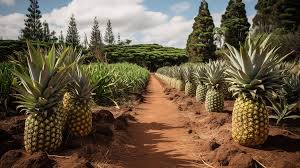Looking for a Pineapple Farming Guide in Nigeria plus a business plan to go with alongside? Read this article as an enthusiast or an academic to know more.
One of Nigeria’s most significant commercial fruit crops is the pineapple. Because of its sweetness and pleasant taste, it is one of the most well-known fruits in the entire globe. A good dose of vitamins A and B, vitamin C, and minerals including calcium, magnesium, potassium, and iron may be found in pineapple. It is also a source of the digestive enzyme bromelain. The fruit may be preserved and processed in a variety of ways in addition to being eaten fresh. The projected yearly global fruit production is 7.9 million tonnes. With 1.4 million tonnes produced annually, Nigeria ranks seventh among pineapple producers.
The ideal places to produce pineapples are where there is a lot of rain. Although it may thrive in regions with 500 mm to 5550 mm of rainfall, 1500 mm per year of rainfall is ideal. Pineapple can grow well in the humid tropics. As long as the temperatures are not too high, the fruit may grow both in the interior and close to the sea coast. The fruit may thrive both inland and close to the ocean as long as the temperature is between 15.5 and 32.50 C. Low temperatures, direct sunlight, and complete shadow are all bad. It may thrive in environments up to 1525 meters above sea level.

Pineapple can thrive in practically any soil type as long as it drains well. For growing pineapples, soil with a pH between 5.5 and 6.0 is said to be ideal. The soil has to have a light texture and good drainage. The soil should not be heavy clay. It may flourish on laterite, alluvial, or sandy soil.
Planting Material Required for Pineapple Production:

The typical pineapple propagation methods are through sucker, slip, and crown. With the exception of crowns, which yield blooms after 19–20 months, these planting materials that are 5–6 months old begin to bloom after 12 months after planting. Tissue-cultured pineapple plants are also available for cultivation.
The cultivation of crops at high densities is advised for economic viability. For sub-tropical and mildly humid conditions, a plant density of 63,400 plants/ha (22.5 x 60 x 75 cm.) is ideal, whereas for hot and humid conditions, a plant density of 53,300 plants/ha (25 cm. from plant to plant within a row, 60 cm. from row to row, and 90 cm. from trench to trench) provides a high yield. A somewhat lower density of 31,000 plants/ha is advised in parts of northeastern states that receive rain, are highly productive, and are mountainous.
There are four different planting methods used: flat-bed, furrow, contour, and trench. The planting method varies depending on the terrain and rainfall. Terracing or contour planting is used on slopes to assist prevent soil erosion.
In pineapple production, earthing up is a crucial procedure intended to provide strong anchoring to plants. It entails moving dirt from the ridge where trench planting is frequently done into the trench. Since pineapple roots are relatively shallow, plants ultimately become trapped, especially when flat-bed planting is done in regions with high rainfall.
Plants that are lodged while their fruits are still growing will grow unevenly, mature unevenly, and ripen unevenly. As the plant’s base rises upward with each successive crop, this activity becomes increasingly crucial in ratoon crops. High-density planting would reduce the need for this procedure since the plants would support one another to prevent lodging.

The shallow feeder pineapple has a high need for potassium and nitrogen. The procedures around the timing of application and the kind of fertilizer dictate how effectively these nutrients are used because they are subject to significant losses in the soil. According to experts’ recommendations based on research studies carried out at various sites, each plant should receive 12 g of N and K2O. No need exists for P application. However, 4 g of P2O5/plant can be administered if the soils are low in P.
There should be six separate applications of nitrogen. Two months after planting, the first dosage of N can be administered, and twelve months later, the final dose. Potash should be administered in two separate dosages. It is possible to apply the entire dose of P and half of the dose of K at the time of planting, and the remaining K six months later. Under rainfed situations, fertilizer must be applied when there is moisture available.
Harvesting and Yield of Pineapples:
Depending on the kind, timing of planting, type and amount of plant material utilized, and ambient temperature during fruit growth, pineapple plants blossom 12–15 months after planting, and the fruits are available 15–18 months after planting. In its natural state, pineapple is harvested between May and August. Normally, the fruit ripens five months after blossoming. The harvest is stretched out over a lengthy period of time as a result of irregular blossoming. One month before to blooming, plants are treated with Ethrel (@ 100 ppm) solution to ensure consistent flowering (above 80%) during the main season.
This Pineapple Farming Guide in Nigeria comes to an end. Are you ready to get a business plan alongside?
How To Download The Complete Pineapple Farming Business Plan for Broilers and Layers In Nigeria PDF and Doc
Above is a part of the pineapple farming business plan in Nigeria. In case you want the complete business plan, follow the procedures to download it.
Pay the sum of N8000 (Eight thousand naira only) to the account detail below:
Bank: GTBank
Name: Oyewole Abidemi (I am putting my name and not our company account so you know I am real and you can trust me, and trace me)
Ac/No: 0238933625
Type: Saving
P.S: We can also tailor the business plan to your name, business size, capital requirements, and more to fit your direct needs. Call or message +234 701 754 2853 for enquiries
Thereafter, send us your email address through text message to +234 701 754 2853. The text must contain the title of the business plan you want and also your email address. Immediately after the confirmation of your payment, we will send the pineapple farming business plan for broilers and layers in Nigeria to your email address where you can easily download it.
Thanks for reading this Pineapple Farming Guide in Nigeria
